-
Languages ENGLISH
-
Call 24/7 +39 030 764 1043
-
Open Hours Mon - Sat: 9am to 6pm

The Follicular Unit Transplantation (FUT), often touted as a game-changer in treating hair loss, is not without its potential pitfalls. Despite the promise of restoring hair to thinning or balding areas, it has been the focus of considerable scrutiny and criticism. This article delves into the reasons why FUT may not be the best option for everyone and offers guidance on how to recover if the procedure goes wrong.
FUT is a hair restoration procedure where a strip of skin, replete with hair follicles, is extracted from the back or side of the patient’s scalp. Post extraction, these follicles are inserted into the balding regions of the scalp. This procedure is typically completed within 4 to 8 hours and is generally quicker than its counterpart, the Follicular Unit Extraction (FUE).
The success of FUT largely depends on the quality and quantity of hair available for grafting. It’s most effective for men with androgenic alopecia, a condition that typically results in an M-shaped hairline with hair loss at the temples. Women with this condition generally experience thinning at the top of their heads or along their hair part. However, FUT may not be suitable for individuals whose hair loss is caused by certain medical conditions like thyroid disorders or alopecia areata.
While FUT might be a viable solution for some, it’s essential to be aware of the potential risks and complications that may arise. These include:
One of the most significant risks associated with FUT is the potential for an unnatural-looking hairline. This can occur if the surgeon places the implanted hair improperly, leading to an artificial appearance and potential scarring.
Scarring is a common side effect of FUT, primarily due to the surgical extraction of a strip of skin from the scalp. These scars can sometimes prevent hair from growing in the affected area, leading to permanent bald spots. Infections, although rare, can also occur post-surgery, particularly if the clinic does not adhere to stringent sanitation protocols.
Hypoesthesia (reduced sense of touch or sensation) or neuralgia (severe pain along the course of a nerve) can occur after FUT. These are often due to injury to the nerves during the surgical procedure.
Donor hair effluvium, or shock loss, is a common occurrence where transplanted hair falls out within two months after surgery. This is typically temporary, with full recovery seen within four months.
There are several reasons why FUT might not yield the desired results:
Clinics using outdated equipment and techniques may be unable to ensure the successful transplantation of hair follicles, leading to a poor outcome.
Poor communication between the medical team and the patient can lead to misunderstandings about the procedure, its risks, and the expected results.
The expertise of the medical staff plays a crucial role in the success of the surgery. Poorly trained staff can lead to errors during the procedure, affecting the final outcome.
Proper aftercare is crucial to the success of a hair transplant. Neglectful aftercare advice can lead to complications such as infections and poor hair growth.
Patients should be wary of clinics that oversell the results of a hair transplant. Unrealistic promises can lead to dissatisfaction and emotional distress when the expected results are not achieved.
If you’ve had a FUT hair transplant that didn’t go as planned, don’t lose hope. There are several options available to rectify the situation:
A revision hair transplant surgery can correct any uneven or misplaced results from the previous surgery. Depending on the extent of the initial procedure, this might involve harvesting donor hair from new areas of your scalp.
If your transplant looks thin or patchy, medications like finasteride or minoxidil can help stimulate hair growth. However, these medications are usually temporary, and the results will reverse once you stop taking them.
Scalp micro-pigmentation is a non-surgical procedure that creates the illusion of thicker hair. This can be an effective method for correcting bald patches and is an ideal choice for individuals who do not want additional invasive surgeries.
In specific complications such as scalp necrosis, surgery might be required to remove all dead tissue from your scalp and prevent further infection.
While FUT hair transplant can offer a permanent solution to hair loss, it’s essential to be aware of its potential risks and complications. If you’ve had a poor experience with FUT, seek professional advice on the best course of action to rectify the situation. Always remember to choose a reputable clinic with highly skilled staff for any hair transplant procedure.
BlueMagic Group Clinic prioritizes the safety and satisfaction of our clients, which is why we have made the decision not to offer the FUT (Follicular Unit Transplantation) hair transplant method. FUT, while effective, comes with certain risks such as linear scarring and a longer recovery period. Instead, we proudly embrace cutting-edge technological advancements such as Sapphire FUE (Follicular Unit Extraction) and DHI (Direct Hair Implantation). These innovative methods not only yield superior results but also minimize side effects and risks associated with traditional approaches.
Our commitment to excellence and client well-being is exemplified by our exclusive focus on the most advanced and safest techniques in the field of hair transplantation. For those seeking more information and personalized guidance, we invite you to book a free hair transplant consultation through our website, where our experienced professionals can discuss the best options tailored to your individual needs.
Hair Transplant Timeline: Real Patient Journey to Istanbul
Curious to know how your hair transplant would go? Connect with us today and let us help you understand each and everything with the help of the experts. & let us give you complete details with the help of a free consultation.
 Get free consultation
Get free consultation
Kindly fill up this form and we will get back to you at the earliest.